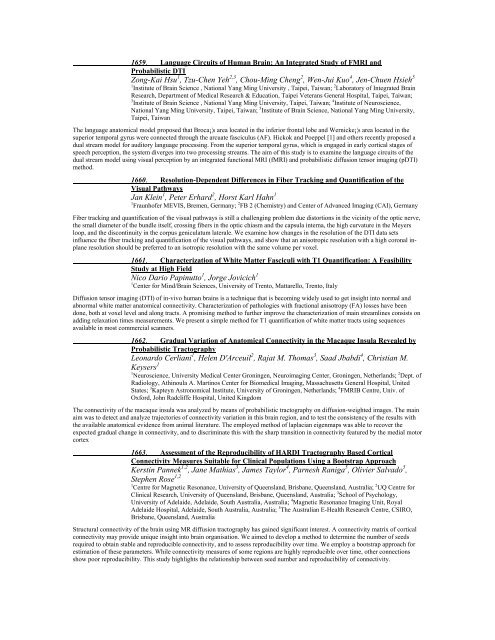Traditional Posters: Diffusion & Perfusion - ismrm
Traditional Posters: Diffusion & Perfusion - ismrm
Traditional Posters: Diffusion & Perfusion - ismrm
Create successful ePaper yourself
Turn your PDF publications into a flip-book with our unique Google optimized e-Paper software.
1659. Language Circuits of Human Brain: An Integrated Study of FMRI and<br />
Probabilistic DTI<br />
Zong-Kai Hsu 1 , Tzu-Chen Yeh 2,3 , Chou-Ming Cheng 2 , Wen-Jui Kuo 4 , Jen-Chuen Hsieh 5<br />
1 Institute of Brain Science , National Yang Ming University , Taipei, Taiwan; 2 Laboratory of Integrated Brain<br />
Research, Department of Medical Research & Education, Taipei Veterans General Hospital, Taipei, Taiwan;<br />
3 Institute of Brain Science , National Yang Ming University, Taipei, Taiwan; 4 Institute of Neuroscience,<br />
National Yang Ming University, Taipei, Taiwan; 5 Institute of Brain Science, National Yang Ming University,<br />
Taipei, Taiwan<br />
The language anatomical model proposed that Broca¡¦s area located in the inferior frontal lobe and Wernicke¡¦s area located in the<br />
superior temporal gyrus were connected through the arcuate fasciculus (AF). Hickok and Poeppel [1] and others recently proposed a<br />
dual stream model for auditory language processing. From the superior temporal gyrus, which is engaged in early cortical stages of<br />
speech perception, the system diverges into two processing streams. The aim of this study is to examine the language circuits of the<br />
dual stream model using visual perception by an integrated functional MRI (fMRI) and probabilistic diffusion tensor imaging (pDTI)<br />
method.<br />
1660. Resolution-Dependent Differences in Fiber Tracking and Quantification of the<br />
Visual Pathways<br />
Jan Klein 1 , Peter Erhard 2 , Horst Karl Hahn 1<br />
1 Fraunhofer MEVIS, Bremen, Germany; 2 FB 2 (Chemistry) and Center of Advanced Imaging (CAI), Germany<br />
Fiber tracking and quantification of the visual pathways is still a challenging problem due distortions in the vicinity of the optic nerve,<br />
the small diameter of the bundle itself, crossing fibers in the optic chiasm and the capsula interna, the high curvature in the Meyers<br />
loop, and the discontinuity in the corpus geniculatum laterale. We examine how changes in the resolution of the DTI data sets<br />
influence the fiber tracking and quantification of the visual pathways, and show that an anisotropic resolution with a high coronal inplane<br />
resolution should be preferred to an isotropic resolution with the same volume per voxel.<br />
1661. Characterization of White Matter Fasciculi with T1 Quantification: A Feasibility<br />
Study at High Field<br />
Nico Dario Papinutto 1 , Jorge Jovicich 1<br />
1 Center for Mind/Brain Sciences, University of Trento, Mattarello, Trento, Italy<br />
<strong>Diffusion</strong> tensor imaging (DTI) of in-vivo human brains is a technique that is becoming widely used to get insight into normal and<br />
abnormal white matter anatomical connectivity. Characterization of pathologies with fractional anisotropy (FA) losses have been<br />
done, both at voxel level and along tracts. A promising method to further improve the characterization of main streamlines consists on<br />
adding relaxation times measurements. We present a simple method for T1 quantification of white matter tracts using sequences<br />
available in most commercial scanners.<br />
1662. Gradual Variation of Anatomical Connectivity in the Macaque Insula Revealed by<br />
Probabilistic Tractography<br />
Leonardo Cerliani 1 , Helen D'Arceuil 2 , Rajat M. Thomas 3 , Saad Jbabdi 4 , Christian M.<br />
Keysers 1<br />
1 Neuroscience, University Medical Center Groningen, Neuroimaging Center, Groningen, Netherlands; 2 Dept. of<br />
Radiology, Athinoula A. Martinos Center for Biomedical Imaging, Massachusetts General Hospital, United<br />
States; 3 Kapteyn Astronomical Institute, University of Groningen, Netherlands; 4 FMRIB Centre, Univ. of<br />
Oxford, John Radcliffe Hospital, United Kingdom<br />
The connectivity of the macaque insula was analyzed by means of probabilistic tractography on diffusion-weighted images. The main<br />
aim was to detect and analyze trajectories of connectivity variation in this brain region, and to test the consistency of the results with<br />
the available anatomical evidence from animal literature. The employed method of laplacian eigenmaps was able to recover the<br />
expected gradual change in connectivity, and to discriminate this with the sharp transition in connectivity featured by the medial motor<br />
cortex<br />
1663. Assessment of the Reproducibility of HARDI Tractography Based Cortical<br />
Connectivity Measures Suitable for Clinical Populations Using a Bootstrap Approach<br />
Kerstin Pannek 1,2 , Jane Mathias 3 , James Taylor 4 , Parnesh Raniga 5 , Olivier Salvado 5 ,<br />
Stephen Rose 1,2<br />
1 Centre for Magnetic Resonance, University of Queensland, Brisbane, Queensland, Australia; 2 UQ Centre for<br />
Clinical Research, University of Queensland, Brisbane, Queensland, Australia; 3 School of Psychology,<br />
University of Adelaide, Adelaide, South Australia, Australia; 4 Magnetic Resonance Imaging Unit, Royal<br />
Adelaide Hospital, Adelaide, South Australia, Australia; 5 The Australian E-Health Research Centre, CSIRO,<br />
Brisbane, Queensland, Australia<br />
Structural connectivity of the brain using MR diffusion tractography has gained significant interest. A connectivity matrix of cortical<br />
connectivity may provide unique insight into brain organisation. We aimed to develop a method to determine the number of seeds<br />
required to obtain stable and reproducible connectivity, and to assess reproducibility over time. We employ a bootstrap approach for<br />
estimation of these parameters. While connectivity measures of some regions are highly reproducible over time, other connections<br />
show poor reproducibility. This study highlights the relationship between seed number and reproducibility of connectivity.















